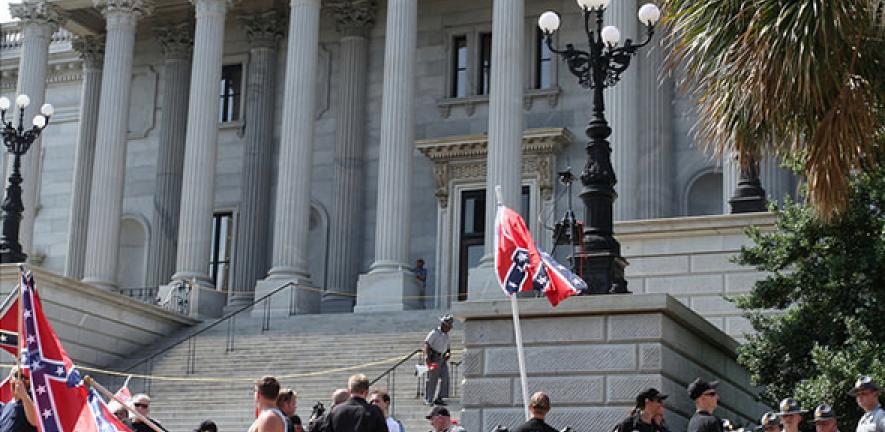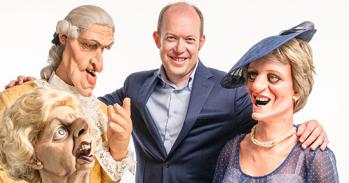
Racism in the US has always run deeper than the electoral cycle, writes Nicholas Guyatt, University Lecturer in American History. Solving it demands education, dialogue, protest, activism and energy.
Racism in the US has always run deeper than the electoral cycle, writes Nicholas Guyatt, University Lecturer in American History. Solving it demands education, dialogue, protest, activism and energy.
Donald Trump’s astonishing rise to the presidency has put racism at the heart of American politics. From the very start of his campaign, Trump called Mexicans “criminals” and “rapists” while pledging to build a wall between the US and its southern neighbour. He shocked the world by promising to ban Muslim visitors from the US, and is now reportedly considering a “Muslim registration system”. He dismissed the concerns of the Black Lives Matter movement and refused to disavow the support he received from white supremacists.
Among his supporters is David Duke, former Grand Wizard of the Ku Klux Klan, who described Trump’s triumph as a victory for “our people”. A week after Trump’s victory, a white nationalist group met in Washington DC to “hail Trump” with Hitler salutes and decry the mainstream media with the Nazi-era term “Lügenpresse”, or “lying press”.
After the symbolic breakthrough of Barack Obama’s presidency, this feels like a shocking step backwards on the issue of race. But it’s important not to overstate America’s progress during the Obama years, nor to ignore the ways in which racism extends far beyond the “whitelash” of Trump’s improbable rise.
Instead, to properly confront America’s racist reality, we need a properly nuanced way to think about it in all its complexity and intractability. Broadly speaking, we can divide racism into three categories: structural, unconscious and unapologetic.
Structural racism refers to the ways racial inequality endures across generations. Racial gaps in household wealth, homeownership and unemployment rates are still enormous. According to the federal government, America’s schools are more segregated today than they were a decade ago. Unarmed African-Americans are substantially more likely to be physically harassed by the police, and around six times as likely to be incarcerated as whites.
Playing into these problems is unconscious racism. This term describes the ways people unintentionally discriminate against others on the basis of race. We know from extensive research that many employers treat people of colour differently from whites when they apply for jobs or promotions, even though they insist that they aren’t personally racist. Social scientists call this “unconscious bias”, and many US government agencies, public institutions and companies have only recently begun to tackle it.
With such stark differences at the root of black and Latino experience, why don’t white people see racial equality as an urgent national imperative? Unconscious racism shapes and sustains structural racism, and leads white people away from the facts of persistent inequality. This interplay helps to explain how American society fails to prioritise racial justice despite the existence of these enormous divides.
From implicit to explicit
The third form of racism is what we’ve seen in the Trump campaign: overt efforts to stereotype or rank people on the basis of race, and “dog-whistle” racism which uses coded language to achieve the same effect.
Overt racism is alarming and dangerous, and has the potential to set back race relations considerably. But to solve the deeper problem of race relations, the US’s leaders must not only condemn the unapologetic racists of the far-right; they must tackle racism’s structural and unconscious dimensions. This can only happen if the past and the present are kept in sharp focus.

Black people in America were denied the opportunity to own property for centuries; in fact, they were themselves held as property, and exploited to produce enormous wealth for their white owners and for the nation more broadly. Even after slavery was abolished in 1865, African-Americans were subjected to another century of open discrimination in housing, employment and every other aspect of communal life.
As did the emergence of a black middle class in the 1960s and 1970s, Barack Obama’s rise to the White House has had a huge and positive effect on American society. But Obama’s election also enabled some (mostly white) commentators to declare that the US had “moved beyond” race – that the debts of slavery and racism had been paid in full, and that anyone still complaining was guilty of “racial entitlement”.
Armed with this mistaken assumption, many white conservatives have dismissed black complaints of police misconduct as spurious or entitled, insisting that Obama’s victory proved there is no ceiling for people of colour in America. With this cynical twist, they can frame any action against racial inequality as a form of undeserved special treatment.
Obama himself has addressed the question of race sporadically and cautiously, no doubt reasoning that white conservatives would seize on a full-scale assault on unconscious and structural racism as evidence of “bias” or self-interest. With Donald Trump in the White House, Democrats and progressives have a fresh opportunity to attack the problem of racism in all its guises.
They won’t have the support of the president or a Congressional majority, until the 2018 midterm elections at least. But racism has always run deeper than the electoral cycle. Solving it demands education, dialogue, protest, activism and energy. These resources will be in limited supply given the sheer number of challenges thrown up by a Trump presidency, but they will be vital to the work of healing the deepest division in American life.
![]()
Nicholas Guyatt, University Lecturer in American History, University of Cambridge
This article was originally published on The Conversation. Read the original article.

The text in this work is licensed under a Creative Commons Attribution 4.0 International License. For image use please see separate credits above.




